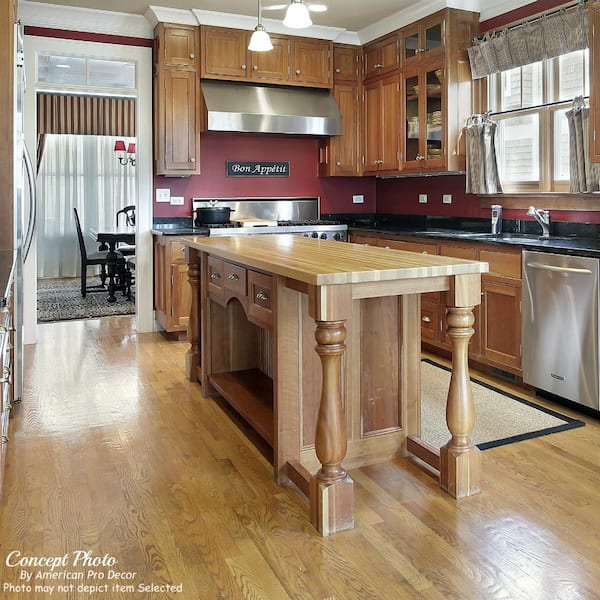Crucial Variables to Take Into Consideration When Selecting Legs For Kitchen Area Island
Choosing the proper legs for a kitchen island involves a careful analysis of several elements that can considerably influence both capability and visual charm. Among these, the selection of material plays a critical duty in making certain toughness, while the style must enhance the existing decoration. Additionally, considerations such as elevation and weight support are essential for security and comfort. As we explore these components, it ends up being clear that each choice can have significant implications for the general kitchen experience. What subtleties should be considered in each of these groups to achieve the excellent balance?
Product Options
When selecting legs for a kitchen area island, recognizing the various material choices is essential for accomplishing both visual allure and structural stability (Legs For Kitchen Island). The option of product significantly influences not just the longevity of the island however also its total layout and functionality
Steel legs, commonly made from stainless steel or functioned iron, add a contemporary and commercial feel while guaranteeing resilience and stability. These materials are immune to put on and can sustain considerable weight, making them suitable for larger islands.
An additional alternative is crafted materials, like MDF or plywood, which can be much more affordable while still offering a range of finishes. They might not offer the same degree of stability as solid timber or metal. Legs For Kitchen Island. Products such as acrylic or glass can produce a contemporary appearance, though they may call for extra support to make certain security.
Ultimately, the option of material for cooking area island legs must align with the wanted performance and the overall style of the kitchen.
Design and Style

When taking into consideration design, the form and surface of the legs are important. Conical legs can give a feeling of agility and style, while thicker, extra durable legs can share toughness and security. In addition, the surface-- be it repainted, discolored, or natural-- ought to complement the cabinetry and countertop materials to develop a unified appearance.
Additionally, the style of the legs can likewise reflect personal preference. Personalized or attractive legs, such as those including elaborate carvings or unique geometric forms, can offer as prime focus, adding character and individuality to the kitchen area. Eventually, the best choice will certainly not just enhance functionality yet likewise elevate the visual allure, making the cooking area island a standout function of the home.
Height Factors To Consider
Selecting the ideal height for cooking area island legs is essential, as it straight impacts both performance and convenience. The basic elevation for a kitchen island normally ranges from 36 to 42 inches, lining up with usual countertop heights.

It is likewise necessary to account for customers' choices and heights. Customizing the elevation can guarantee a comfy experience for all member of the family, making the cooking area island a much more enjoyable and useful room.
Weight Support
Making certain appropriate weight support for cooking area island legs is important for both safety and security and performance. The kitchen island commonly serves numerous functions, consisting of cooking, eating, and additional storage space, necessitating a durable assistance structure. When picking legs, it is important to consider the general weight ability called for based on the island's planned use and the products that will certainly be put on it.
The selection of material for the legs plays a considerable duty in their weight-bearing capabilities. Solid timber, metal, and durable compounds more info here generally supply superior stamina contrasted to lighter products. Additionally, the style of the legs-- whether they are right, tapered, or have a pedestal form-- can influence their capability to disperse weight properly across the structure.
Constantly get in touch with the supplier's requirements regarding lots restrictions to make certain that the legs can maintain the desired weight without jeopardizing security. In summary, selecting kitchen island legs with adequate weight assistance is crucial for developing a functional and safe cooking room.
Installment and Maintenance
Proper installation and upkeep of kitchen area island legs are crucial for making sure durability and stability. To start, it is necessary to comply with the producer's guidelines throughout setup. This often entails protecting the legs to the island base making use of proper fasteners, making certain that the legs are level and aligned. Making use of a level device can assist prevent tottering and improve the total visual appeal of the cooking area island.
When mounted, regular upkeep is necessary to protect the integrity and appearance of the legs - Legs For Kitchen Island. For wood legs, periodic cleansing with a wet fabric and application of ideal wood polish can protect against moisture damages and keep their finish. Steel legs might require a gentle cleansing solution to eliminate oil and grime, complied with by a completely dry towel to stop corrosion development
In addition, inspect the legs on a regular basis for indicators of wear or damages, such as cracks or loose joints. Tightening screws or bolts as needed can also extend the life-span of the legs. By adhering click to these setup and upkeep techniques, house owners can make sure that their kitchen island remains sturdy and visually appealing for years to come.
Conclusion

Visual comprehensibility is paramount Get the facts in choosing the style and style of legs for a cooking area island, as these components significantly influence the general atmosphere of the room. Conical legs can give a sense of lightness and beauty, while thicker, much more durable legs can communicate toughness and security.Picking the suitable elevation for kitchen area island legs is vital, as it straight influences both capability and convenience. In recap, picking cooking area island legs with ample weight assistance is crucial for developing a secure and useful cooking area.
In final thought, choosing legs for a kitchen area island requires careful consideration of various variables, consisting of product choices, style, height, weight assistance, and installment.